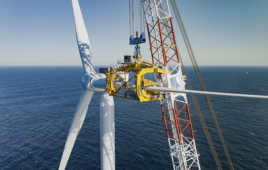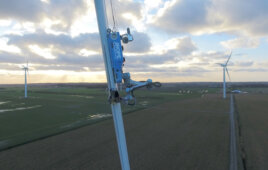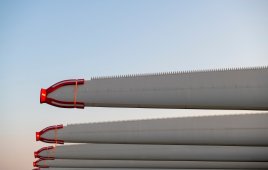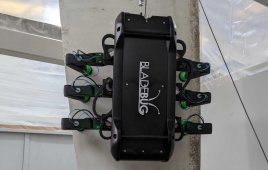
Purdue doctoral student Jonathan White holds a cross section of a wind turbine blade similar to one used in research to improve the efficiency of turbines and prevent damage to blades from high winds. (Photo: Purdue University photo/Andrew Hancock)
Researchers have developed a technique that lets sensors monitor forces exerted on wind turbine blades, a step toward improving their efficiency by letting them adjust to rapidly changing wind conditions. The research by engineers at Purdue University and Sandia National Laboratories is part of an effort to develop a smarter wind turbine. “The goal is to feed information from sensors into an active control system that precisely adjusts components to improve efficiency,” said Purdue doctoral student Jonathan White, who is leading the research with Douglas Adams, a professor of mechanical engineering and director of Purdue’s Center for Systems Integrity.
The system also could help improve wind-turbine reliability by providing critical real-time information to the control system to prevent catastrophic wind-turbine damage from high winds.
The team embedded uniaxial and triaxial accelerometers inside a wind turbine blade as it was built. The sensors measure acceleration in different directions, necessary information to accurately characterize a blade’s bending and twisting and small vibrations near the tip that eventually cause fatigue and possible failure.
The sensors also measure two types of acceleration. One type, dynamic acceleration, comes from gusting winds, while the other, static acceleration, results from gravity and steady background winds. It is essential to accurately measure both forms to estimate forces exerted on the blades. The blade is being tested on a research wind turbine at the U.S. Department of Agriculture lab in Bushland, Texas.
Such sensors could be instrumental in future turbine blades with “control surfaces” and simple flaps like those on an airplane’s wings to change blade aerodynamics. Because these flaps would be changed in real time to respond to changing winds, constant sensor data would be critical.
“The industry is most interested in identifying loads exerted on turbine blades and predicting fatigue, and this work is a step toward accomplishing that,” says White.
“It is useful to control the blade pitch to optimize energy capture by reducing forces on the components in the wind turbine during excessively high winds, or increase loads in low winds. This should also help improve reliability. Turbine towers can be 200 feet tall and more, making it expensive to service and repair damaged components,” says White.
The research is funded by the U.S. Department of Energy through Sandia National Laboratories. Sandia is a multiprogram laboratory operated by Sandia Corp., a Lockheed Martin Co., for the U.S. Department of Energy’s National Nuclear Security Administration under contract DE-AC04-94AL85000.
Filed Under: Blades, Sensors




